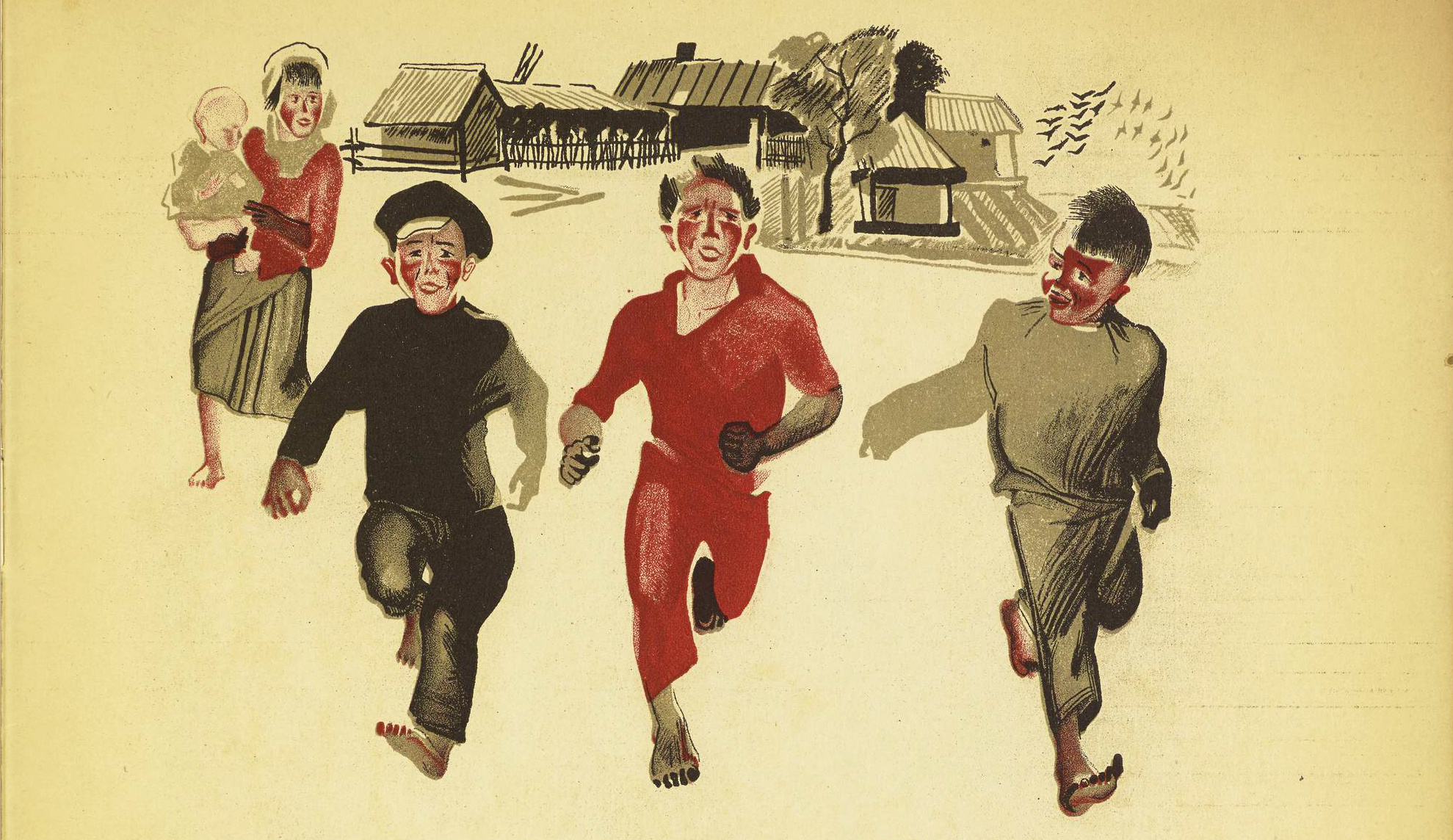Lev Kormchii’s metaphor of children’s literature as a weapon finds its powerful materialization in Mayakovsky’s “The Tale about Pete the Fat Kid and about Sim, Who Is Slim” («Сказка о Пете толстом ребенке и о Симе, который тонкий», 1925). With its stark verbal and visual imagery contrasting the ideal proletarian child to the grotesquely overweight “scum” of a “burzhui” boy, and the plot line of physical mutilation, destruction, and consumption of said undesirable, Mayakovsky’s first children’s poem goes beyond benign prescriptiveness of typical children’s books of the time.
While the poem predictably and typically ties gluttony and obesity to the «bourgeois» lifestyle, it uses the dichotomies of gluttony/moderation, diseased/healthy body, and the proletarian/bourgeois lifestyles to gradually dehumanize Pete, the greedy little boy who cannot stop eating, and to normalize violence against him and others with non-normative bodies and deviant eating habits. In the shocking finale of the story, the fat boy Pete explodes, and all the food he has previously gorged on rains down on good Pioneer children, providing them with luxurious lunch in addition to their humble baked potatoes. Blessed by this macabre manna – butter, sausages, sweets, and other delicious foods – the Pioneers celebrate the abundance and don’t seem to mourn the poor boy, symbolically ingesting him and cleansing the collective child body from the diseased element in a light-hearted way, while preserving their innocence – after all, he did it to himself!
Just like in Mayakovsky’s tale, the intuitive spontaneity (stikhiinost) of Pioneers’ self-organization and the ethos self-reliance were recurrent themes in children’s books of that period and were often illustrated by children’s ability to procure and cook food for themselves, without the traditional reliance on parental figures. A number of books that exemplify the Pioneer code of conduct and romanticize their lifestyle, features campfires and field kitchens built by the Pioneers themselves in order to prepare simple, nutritious food. Similarly to Mayakovsky’s poem, the Pioneers in those books are contrasted with the coddled, dependent children who also typically have overweight, soft bodies, gluttonous (or weak) appetites, predilection for sweets and other luxury foods, and often possess wrong disposition – like the protagonist of Agniia Barto’s “About Lazybones Ivanych,” who happens to be so lazy that he can’t even eat, and in his languor only pokes the food with his fork. Thus, his lack of desire to eat also contrasts with robust (but not excessive) appetite of the exemplary Soviet kids.
 Situated within larger context of early Soviet children’s literature, Mayakovsky’s tale is a remarkable example of an experimental poetic work that uses the tropes and devices of traditional Russian folktale and slapstick humor to shame the gluttonous, grotesque “bourgeois” body and to advance a specific vision of physical health and corporeal docility through food-related topics. Together with Bonch-Bruevich’s “Lenin and Children” (1933) and Zoschenko’s “Short Stories about Lenin” (1940), Mayakovsky’s poem became part of the Soviet food lore, teaching young Soviet kids what and how to eat. Even though the poem was initially condemned by the bureaucrats of Gosizdat as crude, anti-pedagogical, lacking content, and featuring adult humor, it later became a celebrated example of innovative poetry for children and inaugurated Mayakovsky long and successful career as a children’s writer. On a larger scale, “The Tale…” betrays the uneasiness and inconsistencies of the Soviet regime in enforcing physical violence against its enemies, and, unlike other, more tame children’s books of the time, echoed many children’s direct and indirect experiences of violence and aggression, thus becoming what Mayakovsky called “правдашнее стихотворение,” or “truth-reflecting” poem, breaking the rules about accepted topics and language.
Situated within larger context of early Soviet children’s literature, Mayakovsky’s tale is a remarkable example of an experimental poetic work that uses the tropes and devices of traditional Russian folktale and slapstick humor to shame the gluttonous, grotesque “bourgeois” body and to advance a specific vision of physical health and corporeal docility through food-related topics. Together with Bonch-Bruevich’s “Lenin and Children” (1933) and Zoschenko’s “Short Stories about Lenin” (1940), Mayakovsky’s poem became part of the Soviet food lore, teaching young Soviet kids what and how to eat. Even though the poem was initially condemned by the bureaucrats of Gosizdat as crude, anti-pedagogical, lacking content, and featuring adult humor, it later became a celebrated example of innovative poetry for children and inaugurated Mayakovsky long and successful career as a children’s writer. On a larger scale, “The Tale…” betrays the uneasiness and inconsistencies of the Soviet regime in enforcing physical violence against its enemies, and, unlike other, more tame children’s books of the time, echoed many children’s direct and indirect experiences of violence and aggression, thus becoming what Mayakovsky called “правдашнее стихотворение,” or “truth-reflecting” poem, breaking the rules about accepted topics and language.

